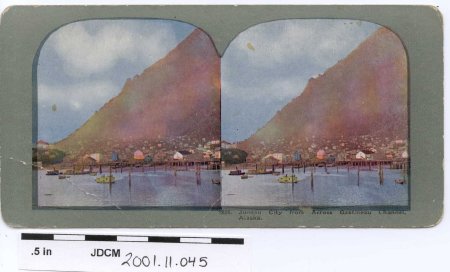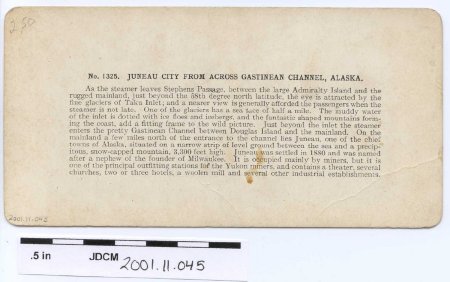Collection:
Juneau—Douglas City Museum
Object ID:
2001.11.045
Accession#:
2001.11
Credit Line:
Donated by Harold Fossum.
Object Name:
Stereoview
Title:
Stereocard, Color, "Juneau Waterfront"
Date:
1910
Scope & Content:
Blue—green card with side by side photos of waterfront view of Juneau. Photos are black and white, colorized with pink, yellow, blue, green and brown. Both pictures depict (from foreground and back): Gastineau Channel, dockside, town with houses and Mt. Juneau. Pictures taken at slightly different angles so when viewed through a stereoscope, will appear 3—D. Inscription under proper left photo: "Juneau City from Across Gastineau Channel, Alaska".
Back: Ivory colored with black print. Upper proper left corner has "2.50" in pencil. Type written inscription in black: "No. 1325. JUNEAU CITY FROM ACROSS GASTINEAU CHANNEL, ALASKA". As the steamer leaves Stephens Passage, between the large Admiralty Island and the / rugged mainland, just beyond the 58th degree north latitude, the eye is attracted by the five glaciers of Taku Inlet; and a nearer view is generally afforded the passengers when the / steamer is not late. One of the glaciers has a sea face of half a mile. The muddy water / of the inlet is dotted with icefloes and icebergs, and the fantastic shaped mountains from — / ing the coast, add a fitting frame to the wild picture. Just beyond the inlet the steamer / enters the pretty Gastineau Channel between Douglas Island and the mainland. On the mainland a few miles north of the entrance to the Channel lies Juneau, one of the chief / towns of Alaska, situated on the narrow strip of level ground between the sea and a precip— / itous snow—capped mountain, 3,300 feet high. Juneau was settled in 1880 and was named / after a nephew of the founder of Milwaukee. It is occupied mainly by miners, but it is / one of the principle outfitting stations for the Yukon miners, and contains a theater, several / churches, two or three hotels, a woolen mill and several other industrial establishments."
Material: Paper/Ink
Back: Ivory colored with black print. Upper proper left corner has "2.50" in pencil. Type written inscription in black: "No. 1325. JUNEAU CITY FROM ACROSS GASTINEAU CHANNEL, ALASKA". As the steamer leaves Stephens Passage, between the large Admiralty Island and the / rugged mainland, just beyond the 58th degree north latitude, the eye is attracted by the five glaciers of Taku Inlet; and a nearer view is generally afforded the passengers when the / steamer is not late. One of the glaciers has a sea face of half a mile. The muddy water / of the inlet is dotted with icefloes and icebergs, and the fantastic shaped mountains from — / ing the coast, add a fitting frame to the wild picture. Just beyond the inlet the steamer / enters the pretty Gastineau Channel between Douglas Island and the mainland. On the mainland a few miles north of the entrance to the Channel lies Juneau, one of the chief / towns of Alaska, situated on the narrow strip of level ground between the sea and a precip— / itous snow—capped mountain, 3,300 feet high. Juneau was settled in 1880 and was named / after a nephew of the founder of Milwaukee. It is occupied mainly by miners, but it is / one of the principle outfitting stations for the Yukon miners, and contains a theater, several / churches, two or three hotels, a woolen mill and several other industrial establishments."
Material: Paper/Ink
Dates of Creation:
1/1/1910
Notes:
Collected and preserved by donor's wife, Helen Fossum.
Per Dick Wood, 1892 image reproduced in 1910.
Joe Juneau was one of the founders of Juneau.
Per Dick Wood, 1892 image reproduced in 1910.
Joe Juneau was one of the founders of Juneau.
Search Terms:
Card
Cityscape
Juneau
Waterfront
Cityscape
Juneau
Waterfront

